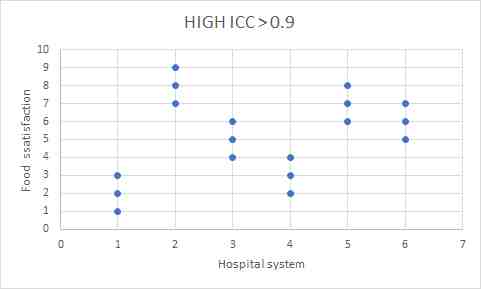One technique that is used to compare two groups in statistics is to measure whether they are correlated or not – for example, if you are trying to correlate whether food consumption and weight gain are related to each other. There are several tests to tell you whether that is true or not.
However, it has been suspected that food in the morning is similar in its effect, let’s say, food consumption before 12 noon – to determine, if food consumption before 12 noon & food consumption through the day were similar to each other in affecting the weight gain. One way would be to compare the food in the morning with the weight gain and then compare food in the full day with the weight gain. A more convenient method is to measure the variation between the two groups. This method of measuring variation between the two groups is called intraclass coefficient (ICC).
It has been used significantly because it is relatively easy to measure, and it is relatively easy to interpret. ICC is expressed on a scale of 0 to 1. With anything closer to 1 is very highly correlated and anything closer to 0 is less correlated.
Much more information and details of this can be found in Wikipedia:
https://en.wikipedia.org/wiki/Intraclass_correlation
Where this gets relevant beyond ICC is to understand its usefulness in pragmatic clinical trials. Pragmatic clinical trials differ from Randomized clinical trial by their purpose – The randomized clinical trial decreases the source of variance from multiple parameters and focuses on primarily one parameter. That one parameter is usually the intervention or the drug/device. In the randomized clinical trial is useful to decrease internal variation. On the other hand, a pragmatic clinical trial takes into account various parameters in the real world setting and seeks to find a pattern in complex real world setting. A definition of pragmatic clinical trial from an NIH website: https://rethinkingclinicaltrials.org/chapters/design/experimental-designs-randomization-schemes-top/experimental-designs-and-randomization-schemes-introduction/
In these trials, individuals are randomized to treatment arms but there is correlation between clusters – the patients are naturally in clusters. These could be groups of patients in different hospitals or there is some correlation between them. In the graph example, the ICC is naturally high because the variation between the groups is similar. Thus, a high ICC is a good correlate of similarity between groups though the actual values (along Y-axis) is different.
In pragmatic clinical trials, that are in real world, patients are grouped into clusters and thus finding out their ICC tells you more about the data and helps you understand more about the studies
Read this for more information:
https://dcricollab.dcri.duke.edu/sites/NIHKR/KR/Intraclass_Correlation_Coefficient_Cheat_Sheet_March_15_2020.pdf
